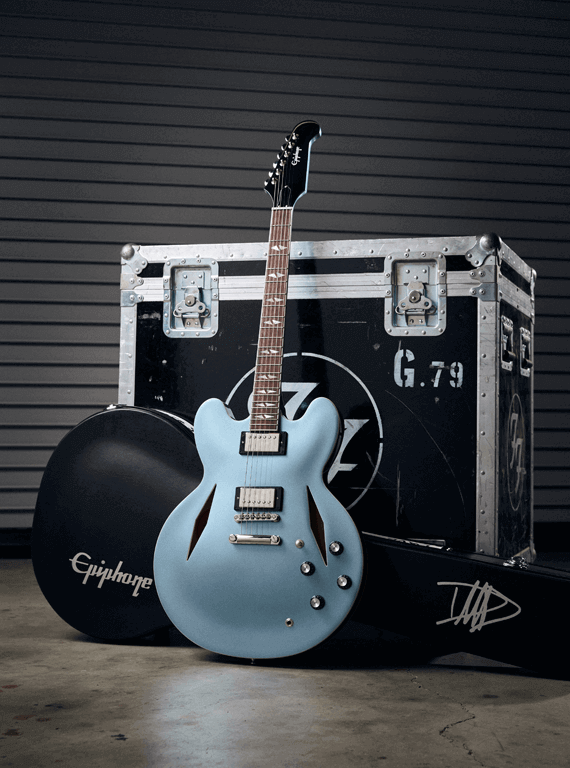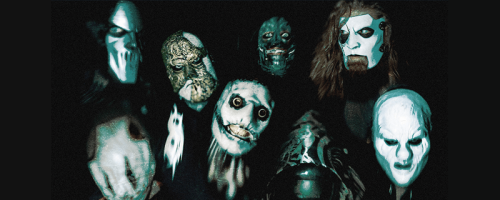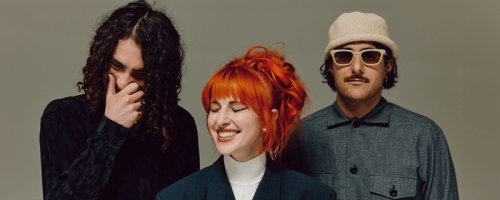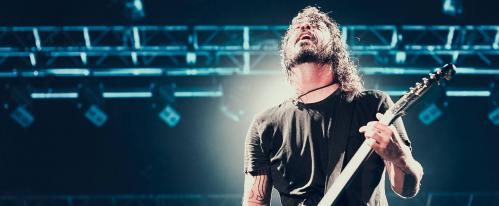Welcome to the ultimate guide to the gear that fuels the legendary sound of the Foo Fighters. From the thundering riffs of Dave Grohl to the melodic undertones of Chris Shiflett, the Foo Fighters have carved their place in rock history with their electrifying performances and anthemic hits. In this comprehensive guide, we'll take a deep dive into the guitars, amps, pedals, and more that define the signature sound of one of the most iconic rock bands of our time. Join us as we uncover the tools of the trade that have propelled the Foo Fighters to superstardom and inspired countless musicians around the world.
Dave Grohl
Heralded as one of the most iconic influences in modern-day rock music, Dave Grohl belongs to the very elite club of being in two legendary bands: first off gaining fame as the drummer for Grunge band royalty, Nirvana, and then after Nirvana disbanded, Grohl formed Foo Fighters in 1995, playing all instruments on their debut album.
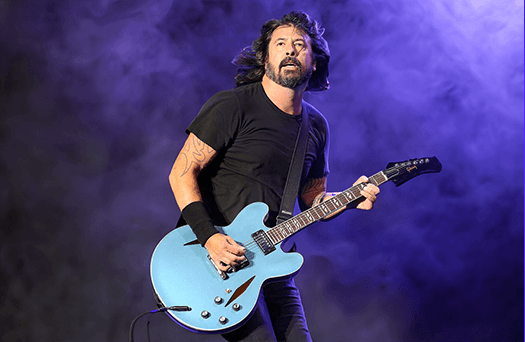

What Guitar Does Dave Grohl Use?
Electric Guitars
Gibson Custom Shop DG-335 Dave Grohl Signature
The Gibson Dave Grohl Custom DG-335 pays homage to the rock icon's beloved Trini Lopez signature model, meticulously crafted by the artisans at the Gibson Custom Shop. With Grohl's personal input, this guitar embodies the essence of the Foo Fighters' lead singer; offering fans a chance to harness his legendary sound. Based on Gibson's classic ES-335 semi-hollow body, the Inspired By DG-335 features a striking Firebird-style headstock and diamond f-holes, reminiscent of the Trini Lopez design.
The rare Pelham Blue finish adds a touch of exclusivity to this limited edition model. Acrylic split diamond inlays on the rosewood fretboard maintain the unique Trini Lopez heritage, while Burstbucker 1 and Burstbucker 2 pickups deliver the same articulate distortion and rich tones that have defined Grohl's music with the Foo Fighters.
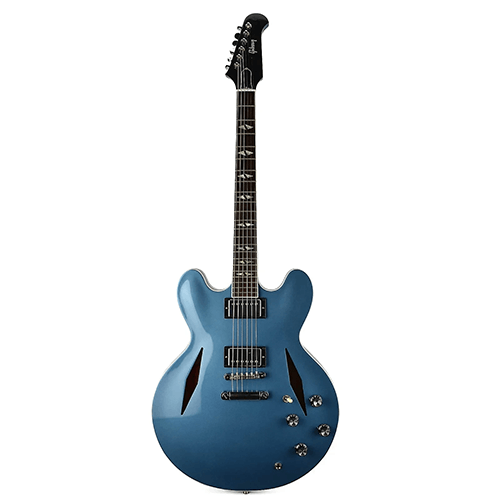

Epiphone Dave Grohl DG-335 Electric Guitar, Pelham Blue
A new release at the time of writing, the Epiphone Dave Grohl DG-335 is crafted with an ES body featuring bound diamond sound holes, a one-piece mahogany neck with an elliptical C profile, and Gibson USA Burstbucker pickups, this guitar is a powerhouse of vintage-inspired tones. Complete with Grover Mini Rotomatic tuners and premium hardware, the Epiphone DG-335 doesn’t just deliver exceptional sound, but also reliability and style in equal measure. Whether you're a die-hard fan or a budding rocker, this guitar promises versatile tones that caters to a wide span of styles.
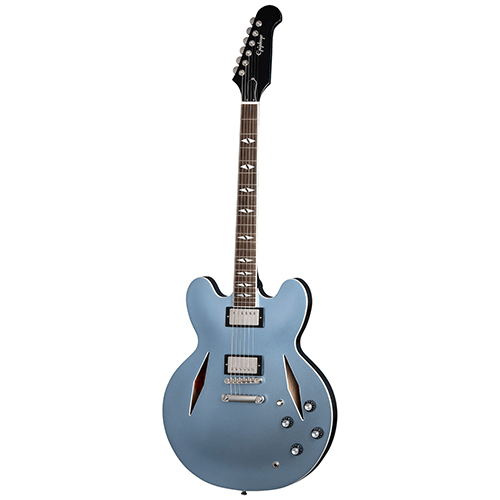

Acoustic Guitars
Gibson Elvis Presley Dove
The Gibson Elvis Presley Dove pays tribute to Elvis Presley's 1969 Gibson Dove acoustic guitar, famously gifted to him by his father, Vernon Presley. This iconic instrument, used by Elvis in the early '70s, holds a special place in music history. In a memorable moment during a 1975 concert in Asheville, North Carolina, Elvis surprised fans by handing the guitar to an audience member mid-performance.
Notably, Dave's guitar does not feature the Pearloid inlays on the bridge "wings" seen in the most recent version of the model introduced in 2022. This detail distinguishes it from the latest iteration.
According to Gibson's specifications, the guitar boasts a Sitka spruce top, maple back and sides, and a neck with an Indian rosewood fretboard adorned with mother-of-pearl parallelogram inlays.


What Amplifiers Does Dave Grohl Use?
VOX AC30
This amp has been Dave's primary choice for many years, dating back to the early days of Foo Fighters. Typically, he relied on it for clean tones, reserving Mesa Boogies or other amps for the grittier sounds.
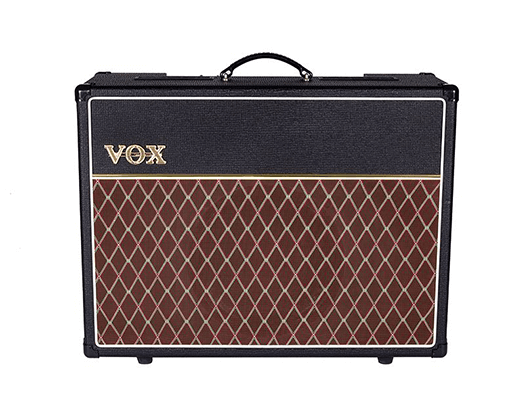

For instance, the amp played a significant role in recording "There Is Nothing Left to Lose" (1999).
What Pedals Does Dave Grohl Use?
Despite his diverse musical portfolio, Dave Grohl has maintained a surprisingly simple guitar rig that’s remained consistent throughout the Foo Fighters' long history. His pedalboard is straightforward, featuring staples like the Boss DM-2 Delay, Boss DD-3 Delay, and MXR Phase 90.
While he used a ProCo Rat Distortion on the band's first album for overdubs, it's uncertain if this made it to his live setup. Photos also suggest occasional use of a Keeley Katana Boost, likely to enhance specific amps rather than his core tone. Notably, Grohl's pedalboard often includes a Boss Chromatic Tuner, possibly two, and both the Boss DM2 and DD-3 Delay pedals for subtle ambience. The MXR Phase 90 plays a significant role in songs like "Breakout," where he sets it at 11 o'clock for the iconic intro.
Pro Co RAT2 Distortion Pedal
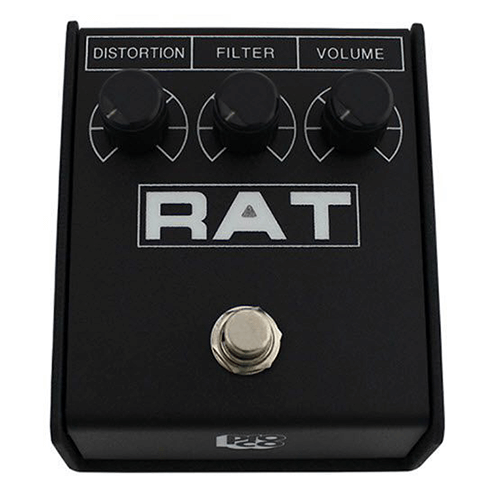

MXR M101 Phase 90 - Orange Phaser Pedal


BOSS DD-3T Digital Delay Pedal
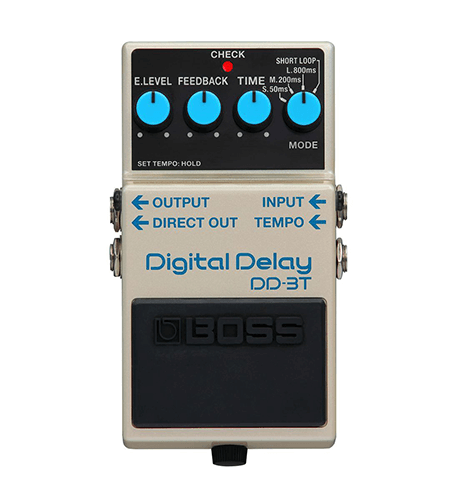

BOSS TU-3 Chromatic Tuner
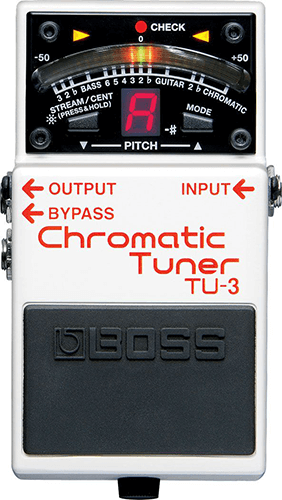

Chris Shiflett
Joining the group in 1999, he brought his melodic and versatile guitar style to the band's sound. Shiflett's guitar work is a defining element of Foo Fighters' music, blending seamlessly with Dave Grohl's vocals and the band's energetic rock sound. His contributions can be heard on numerous Foo Fighters albums, including hits like "The Pretender" and "Best of You." Outside of Foo Fighters, Shiflett has pursued solo projects and side bands, showcasing his songwriting skills and diverse musical influences. His presence in the band adds depth and richness to their renowned live performances.
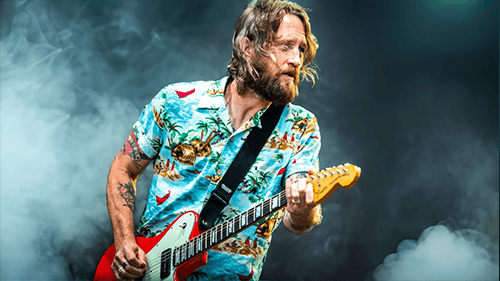

Electric Guitars
Fender Chris Shiflett Telecaster Deluxe Electric Guitar
As a longtime member of the Foo Fighters, he's known for his impeccable punk and hard rock prowess. Yet, Shiflett also has a genuine passion for country music, which shines through in his side project, Chris Shiflett & the Dead Peasants.
His affinity for Telecasters and the rich, powerful sound of humbucking pickups culminates in the Chris Shiflett Telecaster Deluxe. This instrument blends the best of both worlds: the edgy rock tone of the Foo Fighters with the twangy, country-inspired sounds he loves. It's an awesome signature guitar designed for versatility and style.
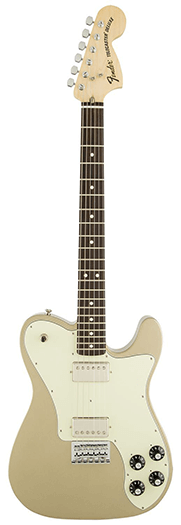

Amplifier
Friedman Brown Eye 100W Tube Guitar Amp Head
When you play in an arena-filling, three-guitar rock band, you need to make sure your guitar tone is cutting through. Shiflett toggles between the custom, two-channel Friedman Brown Eye 100W head and the Vox AC30 head. For the heavier, distorted songs, he opts for the Friedman, while the Vox is used for softer songs like “Aurora.” Both 4x12 stacks have a backup head.
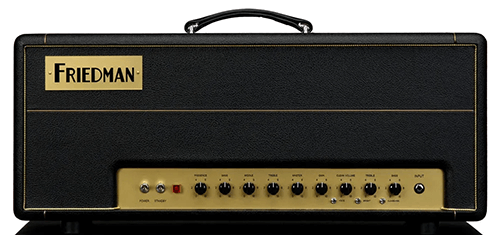

What Pedals Does Chris Shiflett Use?
Shifty's pedalboard is a mix of his go-to favourites. The lineup includes Xotic Effects pedals: an XW-1 wah, SP Compressor, and EP Booster, a long-standing favourite. Adding punch is the Klon KTR Professional overdrive, a more accessible version of the sought-after Klon Centaur. Surprising additions include the rare JHS VCR volume, chorus, and reverb pedal, later rebranded due to controversy. Two Strymon Timeline delays, one for his Friedman amp and one for his Vox, are controlled by a Lehle Little Dual II switcher. Shiflett's choice fuzz is the JHS Muffuletta, alongside affordable picks like the Electro-Harmonix Holy Grail reverb, EVH Phase 90 phaser, MXR M117R Flanger, and Boss CE-2W Chorus. For pitch shifting, he relies on the EHX Micro POG and tuning with the TC Electronic PolyTune 3. This setup offers inspiration for players on a budget, with Shiflett's fondness for the flanger and phaser as classic go-tos.
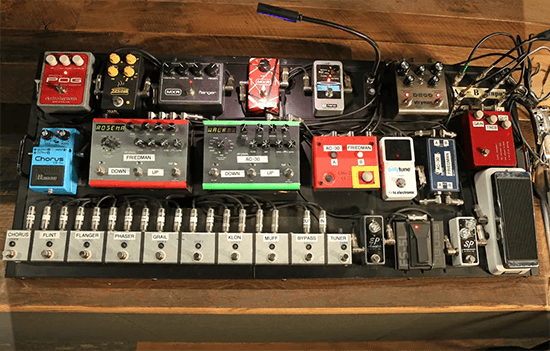

Pat Smear
Initially joining Nirvana as a touring guitarist in their final months, Pat Smear continued with Dave Grohl in the formation of Foo Fighters before then stepping away during the promotion for the second album, The Colour and The Shape. Later rejoining, Smear’s contributions to the band have been significant, playing on their debut album and subsequent releases. His distinctive guitar style, blending punk rock with melodic sensibilities, has left a mark on their sound.
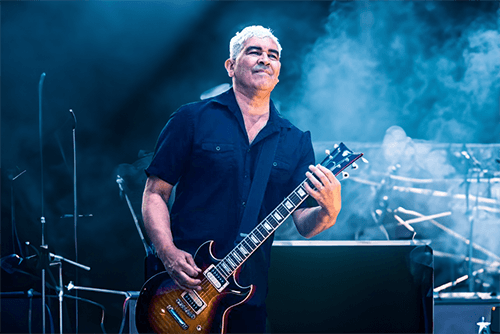

What Guitar Does Pat Smear Use?
Hagstrom Pat Smear Signature
Upon his return to the Foo Fighters as a touring member from 2005 onwards and then once again as a full-time member in 2010, Smear almost exclusively used his collection of Hagstroms.
Consequently, the company decided to create a signature model specifically for him, launching the Pat Smear Signature in 2013. The model is based on a custom-made Hagstrom that he used frequently in his second tenure in the Foo Fighters, which itself was based closely on the company’s Super Swede and Smear’s beloved Hagstrom HIIN.


What Amplifier Does Pat Smear Use?
Laney L50H Lionheart Class A 50-watt head
The L50H amplifier boasts a pure Class A Single Ended topology, featuring five carefully selected and matched EL34B-STR tubes arranged in parallel. This configuration delivers 10 watts RMS per tube, resulting in a distinct and unparalleled sound quality. The amp includes two channels, Clean and Drive, each with separate volume controls and a shared EQ for easy customization. Additionally, it offers a Bite Switch for added punch, Reverb for spaciousness, overall Tone adjustment, and a Dynamics control for fine-tuning your sound. With its unique design and versatile features, the L50H provides a previously unattainable sonic experience for discerning musicians.
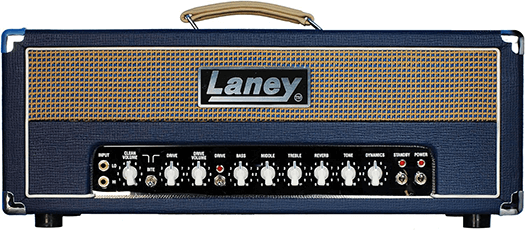

What Pedals Does Pat Smear Use?
Known for his straightforward approach, Pat Smear's pedalboard reflects his preference for simplicity. At the heart of his setup is the RJM LT Mastermind MIDI switcher, allowing seamless control over his effects chain. He adds depth to his tone with the Boss BF-3 Flanger, creating swirling modulation when needed. The Electro-Harmonix Neo Clone Chorus adds lush, analog-like textures to his sound, enhancing the overall atmosphere. To round out his setup, the MXR Carbon Copy Analog Delay provides warm, organic echoes, perfect for adding space and dimension to his guitar lines. Smear's pedalboard may be compact, but it packs a punch in delivering his signature tones.
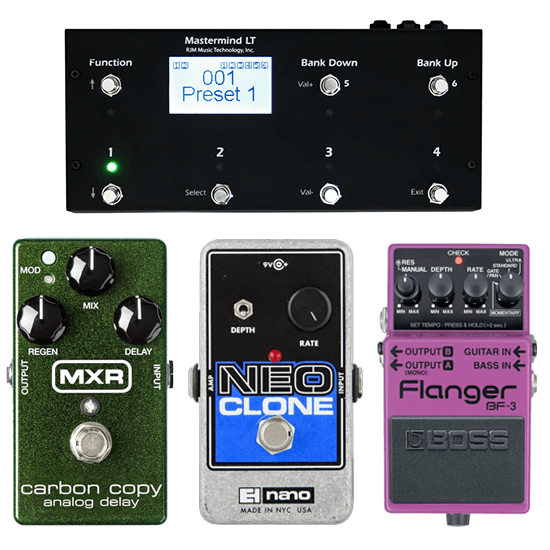

Nate Mendel
Born in Washington, D.C., Mendel joined Foo Fighters in 1995, contributing to their iconic sound with his precise and dynamic bass playing can be heard on tracks such as “Big Me”. Before Foo Fighters, Mendel was a member of the influential band Sunny Day Real Estate. Over the years, he has been an essential part of Foo Fighters' live performances and studio recordings, known for his low-key yet impactful stage presence. Mendel's contributions to the band's success go beyond the basslines, often collaborating on songwriting and arrangements with other members of the group.
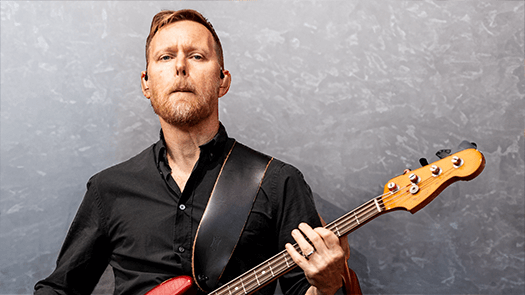

What Bass Does Nate Mendel Use?
Fender Nate Mendel Precision Bass
Over a lengthy career spanning from hardcore punk to Sunny Day Real Estate and the Foo Fighters, Nate Mendel has remained loyal to one main instrument—the 1971 Precision Bass. Fender introduced the Nate Mendel P Bass, crafted after his cherished, battle-tested bass guitar.
This model mirrors its iconic features, such as the unique body contours, slim neck, gently worn finish, and the potent Seymour Duncan pickup. Whether delivering melodic tones or hard-hitting basslines, this bass guitar embodies the spirit of Nate Mendel's enduring musical journey.


What Bass Amp Does Nate Mendel Use?
Ashdown Engineering
Throughout his musical journey, Mendel has remained a steadfast supporter of Ashdown amplifiers, commending the brand for their robust build quality and the rich, solid bottom-end tones that perfectly complement the powerful guitars favoured by Foo Fighters. Mendel's allegiance to Ashdown has seen him endorse various amplifiers over the years, such as the Little Bastard head and the Ashdown BTA 400W valve head.
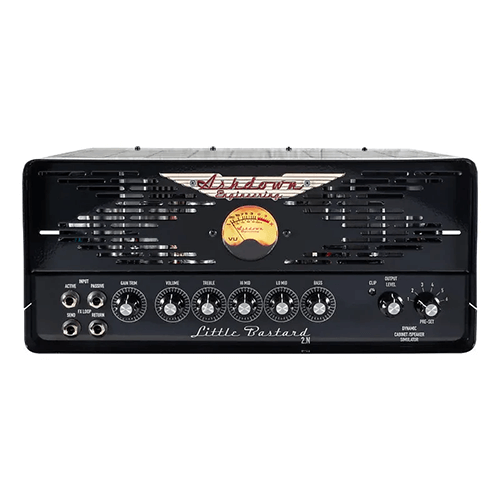

Taylor Hawkins
Before his untimely passing in 2022, Taylor Hawkins brought boundless energy and flair to the band. With a career that includes stints with Alanis Morissette and Sass Jordan, Hawkins joined Foo Fighters in 1997, becoming an integral part of their powerhouse sound. Renowned for his dynamic drumming style and infectious stage presence, Hawkins was also a talented vocalist, contributing lead vocals to several Foo Fighters tracks. Not only that but his rock-solid rhythms and charismatic performances make him a standout figure in the rock music scene.
What Drum Kit Did Taylor Hawkins Use?
Gretsch Drums


Gretsch USA Custom in Bright Pink Gloss Lacquer
- 5x6” & 6x8” Concert Toms
- 9x13” Rack Tom
- 16x16” & 16x18” Floor Toms
- 18x24” Bass Drum
- 6.5x14” Bell Brass Snare Drum
And there you have it, a detailed rundown of the gear that fuels the iconic sound of the Foo Fighters. To recap, Dave Grohl's arsenal includes the Gibson Custom Shop DG-335 and Epiphone DG-335 guitars, paired with the legendary VOX AC30 amplifier and a selection of essential pedals like the Boss DM-2 Delay. Chris Shiflett brings his signature Fender Telecaster Deluxe guitar to life with the Friedman Brown Eye 100W Tube Amp Head and a diverse array of effects pedals. Pat Smear's distinctive tone is shaped by his Hagstrom Pat Smear Signature guitar and Laney L50H Lionheart amplifier, complemented by a compact yet powerful pedalboard.
Nate Mendel lays down the foundation with his Fender Nate Mendel Precision Bass, powered by Ashdown Engineering amplifiers, while Taylor Hawkins drives the rhythm forward with his powerful drumming on his Gretsch Drums kit.
As with any band, the live and studio setups of the Foo Fighters are subject to evolution and experimentation. If you have any further questions or if you're seeking new information about their gear, don't hesitate to reach out. Visit PMT Online or drop by your nearest PMT Store to speak with our knowledgeable experts who can help you find the perfect instruments and accessories to unleash your inner rock star.

